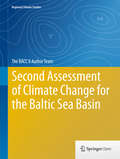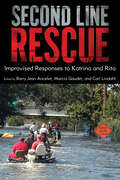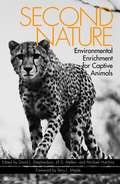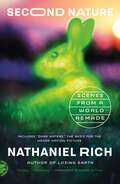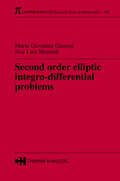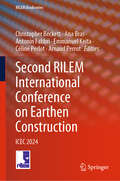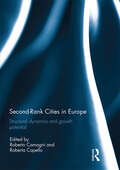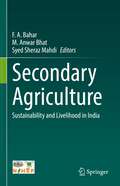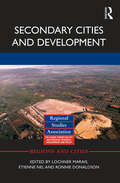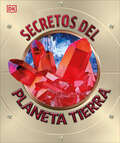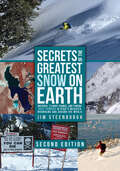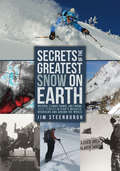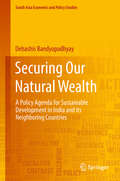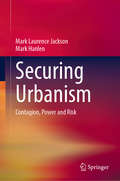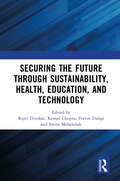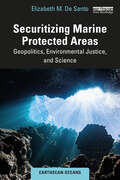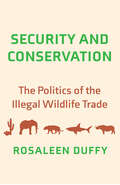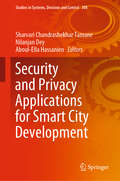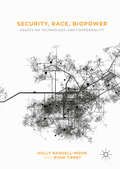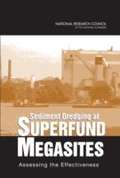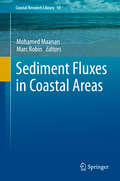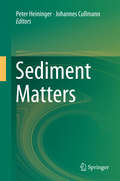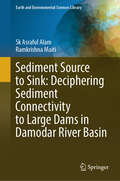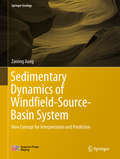- Table View
- List View
Second Assessment of Climate Change for the Baltic Sea Basin
by The BACC II Author TeamThis book is an update of the first BACC assessment, published in 2008. It offers new and updated scientific findings in regional climate research for the Baltic Sea basin. These include climate changes since the last glaciation (approx. 12,000 years ago), changes in the recent past (the last 200 years), climate projections up until 2100 using state-of-the-art regional climate models and an assessment of climate-change impacts on terrestrial, freshwater and marine ecosystems. There are dedicated new chapters on sea-level rise, coastal erosion and impacts on urban areas. A new set of chapters deals with possible causes of regional climate change along with the global effects of increased greenhouse gas concentrations, namely atmospheric aerosols and land-cover change. The evidence collected and presented in this book shows that the regional climate has already started to change and this is expected to continue. Projections of potential future climates show that the region will probably become considerably warmer and wetter in some parts, but dryer in others. Terrestrial and aquatic ecosystems have already shown adjustments to increased temperatures and are expected to undergo further changes in the near future. The BACC II Author Team consists of 141 scientists from 12 countries, covering various disciplines related to climate research and related impacts. BACC II is a project of the Baltic Earth research network and contributes to the World Climate Research Programme.
Second Line Rescue: Improvised Responses to Katrina and Rita
by Barry Jean AnceletSecond Line Rescue: Improvised Responses to Katrina and Rita chronicles the brave and creative acts through which Gulf Coast people rescued their neighbors during the chaotic aftermath of Hurricanes Katrina and Rita. Ordinary citizens joined in with whatever resources they had. Unlike many of the official responders, vernacular rescuers found ways around paralysis produced by a breakdown in communications and infrastructure. They were able to dispel unfounded fears produced by erroneous or questionable reporting. The essays, personal narratives, media reports, and field studies presented here all have to do with effective and often ingenious answers that emerged from the people themselves. Their solutions are remarkably different from the hamstrung government response, and their perspectives are a tonic to sensationalized media coverage. The first part of the collection deals with Gulf Coast rescuers from outside stricken communities: those who, safe in their own homes and neighborhoods, marshaled their resources to help their fellow citizens. It includes some analysis and scholarly approaches, but it also includes direct responses and firsthand field reports. The second part features the words of hurricane survivors displaced from New Orleans and other Gulf Coast communities to Houston, Texas. In many cases, the “victims” themselves were the first responders, rescuing family, friends, and strangers. All of the stories, whether from the “outside” or “inside” responders, reveal a shared history of close-knit community bonds and survival skills sharpened by hard times. This book is about what went right in the aftermath of Katrina and Rita—in spite of all that went so wrong.
Second Nature: Environmental Enrichment for Captive Animals
by Michael Hutchins Jill D. Mellen David J. ShepherdsonGrowing recognition of the complexity of animals' physical, social, and psychological lives in the wild has led both zookeepers and the zoo-going public to call for higher environmental standards for animals in captivity.Bringing together the work of animal behaviorists, zoo biologists, and psychologists, Second Nature explores a range of innovative strategies for environmental enrichment in laboratories and marine parks, as well as in zoos. From artificial fleeing-prey devices for leopards to irregular feeding schedules for whales, the practices discussed have resulted in healthier, more relaxed animals that can breed more easily and can exert some control over their environments. Moving beyond the usual studies of primates to consider the requirements of animals as diverse as reptiles, amphibians, marine mammals, small cats, hooved grazers, and bears, contributors argue that whether an animal forages in the wild or plays computer games in captivity, the satisfaction its activity provides--rather than the activity itself--determines the animal's level of physical and psychological well-being.Second Nature also discusses the ways in which environmental enrichment can help zoo-bred animals develop the stamina and adaptability for survival in the wild, and how it can produce healthier lab animals that yield more valid test results. Providing a theoretical framework for the science of environmental enrichment in a variety of settings, the book renews and extends a humane approach to the keeping and conservation of animals.From the Trade Paperback edition.
Second Nature: Scenes from a World Remade
by Nathaniel RichFrom the author of Losing Earth, a beautifully told exploration of our post-natural world that points the way to a new mode of ecological writing.We live at a time in which scientists race to reanimate extinct beasts, our most essential ecosystems require monumental engineering projects to survive, chicken breasts grow in test tubes, and multinational corporations conspire to poison the blood of every living creature. No rock, leaf, or cubic foot of air on Earth has escaped humanity's clumsy signature. The old distinctions—between natural and artificial, dystopia and utopia, science fiction and science fact—have blurred, losing all meaning. We inhabit an uncanny landscape of our own creation. In Second Nature, ordinary people make desperate efforts to preserve their humanity in a world that seems increasingly alien. Their stories—obsessive, intimate, and deeply reported—point the way to a new kind of environmental literature, in which dramatic narrative helps us to understand our place in a reality that resembles nothing human beings have known.From Odds Against Tomorrow to Losing Earth to the film Dark Waters (adapted from the first chapter of this book), Nathaniel Rich’s stories have come to define the way we think of contemporary ecological narrative. In Second Nature, he asks what it means to live in an era of terrible responsibility. The question is no longer, How do we return to the world that we’ve lost?It is, What world do we want to create in its place?
Second Order Elliptic Integro-Differential Problems (Chapman & Hall/CRC Research Notes in Mathematics Series)
by Maria Giovanna Garroni Jose Luis MenaldiThe Green function has played a key role in the analytical approach that in recent years has led to important developments in the study of stochastic processes with jumps. In this Research Note, the authors-both regarded as leading experts in the field- collect several useful results derived from the construction of the Green function and its estim
Second RILEM International Conference on Earthen Construction: ICEC 2024 (RILEM Bookseries #52)
by Arnaud Perrot Christopher Beckett Antonin Fabbri Ana Bras Emmanuel Keita Céline PerlotThis book gathers the peer-reviewed papers presented at the Second RILEM International Conference on Earthen Construction (ICEC), held in Edinburgh, United Kingdom, on July 8–10, 2024. It highlights the latest advances and innovations in the field of con earth-based building materials and construction. The conference topics encompass material characterisation and quality control, hydro-mechanical behaviour, reinforcement behaviour, seismic behaviour, in situ and field testing, additive manufacturing (3D printing), rheology, biostabilisation, molecular simulation, microstructure, durability, fire performance, hygro-thermal behaviour, life cycle analysis, climate change adaptation, economic impacts, and earthen architecture. As such, the book represents an invaluable, up-to-the-minute tool, and offers an important platform to engineers, architects, and geophysicists.
Second Rank Cities in Europe: Structural Dynamics and Growth Potential
by Roberta Capello Roberto CamagniSecond-rank cities are back on the academic scene, capturing the interest of scholars with their unexpected recent performance with respect to first-rank cities. Looking at the data on average urban GDP growth in 139 European cities since 1996, the relatively strong position of large cities (over 1.5 million inhabitants) on national growth coincides with the periods of fastest expansion, while at times of slowdown second-rank cities prevail. Especially in the recent period of economic downturn, second-rank cities have recorded annual GDP growth rates much less negative than those of capital cities; and in some European countries, like Austria and Germany, all cities have outperformed their capitals. In explaining this phenomenon, linking urban dynamics to agglomeration theories seems the most interesting approach. However, merely to link agglomeration economies to urban size in order to interpret urban performance is neither convincing nor sufficient, and it calls for additional investigation into how agglomeration economies work. This volume claims that interpretation of the current dynamics in European urban systems – especially in the western part of Europe – would benefit from exploitation of the traditional concept of agglomeration economies. However, necessary for this purpose are more in-depth considerations on the nature, scope, intensity, and causes of agglomeration economies which do not relate their existence solely to urban size. And this is where the main challenge for scholars lies, in the interpretation of the missing link between agglomeration economies and urban dynamics. This book was originally published as a special issue of European Planning Studies.
Secondary Agriculture: Sustainability and Livelihood in India
by Syed Sheraz Mahdi F. A. Bahar M. Anwar BhatThis book on ‘Secondary Agriculture’ discusses the goal of doubling farmers’ incomes. The term ‘secondary’ has a bearing on climate change adaptation and its mitigation, small farm viability and profitability, food security, nutrition, sustainable utilization of natural resources, and optimal usage of produce from primary agriculture and farm incomes. Promoting secondary agriculture has implications on attaining sustainable development goals, which aim to connect primary, secondary and tertiary sectors by using slack/idle factors of production, such as land and labour, contributing to primary agriculture production, capturing ‘value’ in primary agricultural activities, and generating additional income at the enterprise level. In context to same, the chapters of this book have been designed to promote secondary agriculture through low-cost skills and technology applications in agriculture and by upscaling knowledge via integrating primary, secondary and tertiary sectors of agriculture. The motivation behind this book is to address the challenges of biotic and abiotic stresses facing the farming community; to increase farmers income through low-cost skills and technology applications in agriculture; to upscale knowledge by integrating primary, secondary and tertiary sectors of agriculture. The food processing sector in India is still in a nascent stage with only 8 per cent of the produce being processed as against 80-98 per cent in case of high-income countries (Government of India, 2008, 2010). The food processing sector is now receiving the boost with the annual growth of 13.2 per cent in registered food processing units during 2004-10 (Government of India, 2011). Against this backdrop, there is a strong need to strategically handle the situation in order to facilitate a self-sustainable and long-run growth of the sector, which is felt possible by focusing on Secondary Agriculture. Though not a panacea for all ailments of the primary sector, but it can definitely drive the growth.
Secondary Cities and Development (Regions and Cities)
by Lochner Marais, Etienne Nel and Ronnie DonaldsonThe role secondary cities play in the global space economy and national urban hierarchies is increasingly receiving attention from scholars and international agencies, most notably the Cities Alliance. Secondary Cities and Development considers the role of secondary cities through the lens of South Africa, a middle-income country with characteristics of both the developed and developing worlds. This book brings together a broad overview of international literature on secondary cities in South Africa and mirrors them against global experience. Chapters emphasize the importance of secondary cities as regional services areas, their potential roles in rural development, the vulnerabilities to which they are prone and their signifcant potential. By means of review, six South African case studies, and an assessment of contemporary policy approaches towards these cities, this unique volume provides insight into a spectrum of globally significant challenges. This book would be of interest to academics and policy makers working in urban studies or regional development.
Secretos del Planeta Tierra (Explanatorium of the Earth)
by DKUna completísima enciclopedia juvenil para explorar nuestro planeta de forma diferente.Emprende un increíble viaje al corazón de nuestro planeta y descubre cómo las placas tectónicasse separan y chocan, observa la erosión que sufre la Tierra a lo largo del tiempo, explora el interior de un volcán, aprende sobre el cambio climático y el calentamiento global y mucho más.¿Cuántos volcanes activos existen? ¿Qué provoca los tornados y los huracanes? ¿Cómo se forman las rocas, los fósiles y las gemas? ¿De qué se compone el aire?Con cantidad de datos curiosos e increíbles fotografías e imágenes de todo tipo de fenómenos, este libro ilustrado para niños responde a todas las preguntas sobre nuestro universo, ya se trate del origen de la vida en la Tierra, la atmósfera, los fósiles, los océanos o la actividad tectónica.Incluye datos asombrosos sobre geología, accidentes geográficos y paisajes, fósiles, rocas y minerales, climatología, el sistema solar y mucho más.Con explicaciones sencillas de más de 100 principios científicos: la materia, las reacciones, los materiales, las fuerzas, la energía, la vida y la Tierra.Impresionantes fotografías de primeros planos, además de increíbles imágenes macro, cortes transversales e imágenes tomadas con time-lapse, rayos X y ultravioleta.Un libro de consulta esencial en las bibliotecas familiares y el complemento perfecto para los trabajos escolares.Perfecto para niños a partir de 9 años interesados en las ciencias de la Tierra y los fenómenos naturales y meteorológicos.Un regalo especial que los niños guardarán como un tesoro.---------------------------------- Welcome to the Explanatorium of the Earth - the only Earth encyclopedia you'll ever need, with excellent photographs of everything from supervolcanoes to tsunamis. This Earth exploration book for kids aged 9-12 and beyond answers the biggest and smallest questions about our universe, whether it’s fossils, oceans, or geology. The Exploratorium of Earth brings science to life with striking photographic explanations, helping kids understand how the world works.This fact-filled encyclopedia for kids offers:An extensive earth science guide– explaining more than 100 scientific principles, including matter, reactions, materials, forces, energy, life, and Earth.Detailed, close-up photography, plus incredible macro images, cross-sections, exploded views, time-lapse, x-ray, and ultra-violet photography.What makes volcanoes erupt? Why are tornadoes and hurricanes so destructive? How do rocks, fossils, and gems form? Explanatorium of the Earth takes you on an incredible voyage deep into the heart of our planet and back to discover the powerful forces that continually shape and remodel our ever-changing world. Discover how tectonic plates tear apart and cause earthquakes. Learn how the slow but relentless process of erosion and weathering wears away rock, reducing mountains to dust and carving valleys and canyons into the land. And learn how the living world and rock cycles have worked together for millions of years to stabilize the planet's climate, keeping Earth suitable for life.Are you interested in other subjects? Explore more from the Explanatorium series, such as Explanatorium of History, Explanatorium of Nature, and Explanatorium of Science.
Secrets of the Greatest Snow on Earth, Second Edition: Weather, Climate Change, and Finding Deep Powder in Utah's Wasatch Mountains and Around the World
by Jim SteenburghUtah has long claimed to have the greatest snow on Earth—the state itself has even trademarked the phrase. In Secrets of the Greatest Snow on Earth, Jim Steenburgh investigates Wasatch weather, exposing the myths, explaining the reality, and revealing how and why Utah’s powder lives up to its reputation. Steenburgh also examines ski and snowboard regions beyond Utah, providing a meteorological guide to mountain weather and snow climates around the world. Chapters explore mountain weather, avalanches and snow safety, historical accounts of weather events and snow conditions, and the basics of climate and weather forecasting. In this second edition, Steenburgh explains what creates the best snow for skiing and snowboarding using accurate and accessible language and 150 color photographs and illustrations, making Secrets of the Greatest Snow on Earth a helpful tool for planning vacations and staying safe during mountain adventures. This edition is updated with two new chapters covering microclimates and climate change in greater depth. Steenburgh addresses the declining snowpack and the future of snow across the western United States, as well as the declining snow and ice in several regions of the world—the European Alps in particular. Snowriders, weather enthusiasts, meteorologists, students of snow science, and anyone who dreams of deep powder and bluebird skies will want to get their gloves on this new edition of Secrets of the Greatest Snow on Earth. Praise for the first edition: “Everything you always wanted to know about how snow forms and how to follow forecasts so you see how much an”d where is in the book. It’s a must-have for any fan of snow, sure to get you excited about winter, and give you a bevy of conversation topics for the chairlift ride.” —Utah Adventure Journal “For backcountry enthusiasts that find themselves infatuated with weather patterns, snow-water equivalents, microclimates, and Utah, this book is a dream come true.” —The Backcountry Skiing Blog “Steenburgh shares a career’s worth of knowledge in this book. His love of both snow science and skiing is obvious, and he adds humor and personality to the scientific discussion.” —First Tracks!! Online Skiing Magazine “When it comes to snow, the details—both small- and large-scale—do matter. If we all observed our surroundings with as much curiosity and enthusiasm as Steenburgh, the world could be a much better- tended place.” —American Scientist
Secrets of the Greatest Snow on Earth: Weather, Climate Change, and Finding Deep Powder in Utah's Wasatch Mountains and around the World
by Jim SteenburghUtah has long claimed to have the greatest snow on Earth—the state itself has even trademarked the phrase. In Secrets of the Greatest Snow on Earth, Jim Steenburgh investigates Wasatch weather, exposing the myths, explaining the reality, and revealing how and why Utah’s powder lives up to its reputation. Steenburgh also examines ski and snowboard regions beyond Utah, making this book a meteorological guide to mountain weather and snow climates around the world. Chapters explore mountain weather, avalanches and snow safety, historical accounts of weather events and snow conditions, and the basics of climate and weather forecasting. Steenburgh explains what creates the best snow for skiing and snowboarding in accurate and accessible language and illustrates his points with 150 color photographs, making Secrets of the Greatest Snow on Earth a helpful tool for planning vacations and staying safe during mountain adventures. Snowriders, weather enthusiasts, meteorologists, students of snow science, and anyone who dreams of deep powder and bluebird skies will want to get their gloves on Secrets of the Greatest Snow on Earth. Watch Book Trailer!(Special thanks to Ski Utah)
Secrets of the Seasons: Orbiting the Sun in Our Backyard
by Kathleen Weidner ZoehfeldThe family from Secrets of the Garden are back in a new book about backyard science that explains why the seasons change.Alice and her friend Zack explore the reasons for the seasons. Alice's narrative is all about noticing the changes as fall turns into winter, spring, and then summer. She explains how the earth's yearlong journey around the sun, combined with the tilt in the earth's axis, makes the seasons happen. Alice's text is clear and simple, and experiential. Two very helpful—and very funny—chickens give more science details and further explanation through charts, diagrams, and sidebars. Packed with sensory details, humor, and solid science, this book makes a complicated concept completely clear for young readers—and also for the many parents who struggle to answer their kids' questions! "Several adults of my acquaintance . . . would find Secrets of the Seasons to be an eye-popping revelation." —John Lithgow, The New York Times Book Review
Securing Our Natural Wealth: A Policy Agenda for Sustainable Development in India and for Its Neighboring Countries (South Asia Economic and Policy Studies)
by Debashis BandyopadhyayThis book explores various aspects of Intellectual Property Rights (IPR) regimes with regard to plant-variety protection and farmers’ rights; traditional knowledge; geographical indications, genetically modified crops; and access to genetic resources within the broad ambit of Trade-Related Aspects of Intellectual Property Rights (TRIPS), the Convention of Biological Diversity and other treaties/protocols. Enumerating the governance provisions for India and some of its neighboring countries, including Nepal, Sri Lanka, Bangladesh, Bhutan, Thailand and Myanmar, the book synthesizes a policy agenda to drive sustainable development. Further, it assesses and interprets the status quo, and discusses key issues and implications. By comparing various governance frameworks in South Asian countries, it attempts to bridge policy issues concerning development, IPR and international studies.
Securing Urbanism: Contagion, Power and Risk
by Mark Laurence Jackson Mark HanlenThis book is concerned with developing an in-depth understanding of contemporary political and spatial analyses of cities. In the three-part development of the book’s overall argument or premise, the reader is taken in Part I through a range of contemporary critical and political understandings of urban securitizing. This is followed by an historical urban landscape of emerging liberalism and neo-liberalism, in nineteenth-century Britain and twentieth-century United States, respectively. These case-study historical chapters enable the introduction of key political issues that are more critically assayed in Parts II and III. With Part II, the reader is introduced in depth to a series of spatial analyses undertaken by Michel Foucault that have been crucial for especially late-twentieth and twenty-first century urban theory and political geography. With Part III the full ramifications of a paradigmatic shift are explored at the level of rethinking territory, population and design. This book is timely and useful for readers who want to develop a stronger understanding of what the book’s researchers term a new political paradigm in urban planning, one ultimately governed by global economic forces that define the end of probability.
Securing the Future through Sustainability, Health, Education, and Technology
by Rajiv Divekar Komal Chopra Smita Mehendale Pravin DangeOrganized on 13th–15th December 2023, The 14th Annual International Research Conference of the Symbiosis Institute of Management Studies, (SIMSARC 2023) is based on the theme “Securing the Future through Sustainability, Health, Education and Technology”. It focuses on the need for a holistic approach to address the present challenges of the world while envisioning a resilient and prosperous tomorrow. It discusses the interconnections between Sustainability, Health, Education and Technology in fostering long-term well-being and addresses challenges and future opportunities.
Securitizing Marine Protected Areas: Geopolitics, Environmental Justice, and Science (Earthscan Oceans)
by Elizabeth M. De SantoThis book presents a novel examination of Marine Protected Areas within a security context, bridging science, policy, and geopolitics, and addressing the often-under-emphasized aspect of environmental justice.The book argues that Marine Protected Areas (MPAs) are not only a critical tool for protecting marine biodiversity in a changing climate, but they also play an important role at the intersection of geopolitics and environmental justice, and they provide a case study of environmental governance at the science-policy interface. The book takes an interdisciplinary and critical approach and builds on the author's two decades of experience working in this field. Geopolitically, it explores the ways in which MPAs provide footprints for influence and access to resources far from home for nations with overseas territories. MPAs also raise important issues connected to equity, environmental justice, and social justice, including access to resources and participation in environmental decision-making processes, key aspects for achieving long-term conservation goals. The book also demonstrates how MPAs are a critical lens for understanding how policy makers cope with scientific uncertainty, and the necessity of well-designed and precautionary science advisory processes. While the ecological contribution of MPAs is paramount, social issues and geopolitical considerations are often less obvious in the discourse underpinning MPAs, and the resulting tensions can undermine long-term conservation objectives. By applying the three lenses of geopolitics, environmental justice and science, this book provides key insights to help the international community moving past the 2030 biodiversity targets and beyond, towards a future of meaningful, equitable, and effective conservation approaches.This book will be of great interest to students and scholars of biodiversity conservation, marine studies, political geography, environmental governance, and science-policy studies. It will also be of interest to marine conservation governance professionals and policymakers.
Security and Conservation: The Politics of the Illegal Wildlife Trade
by Rosaleen DuffyAn exploration of the scale, practical reality, and future implications of the growing integration of biodiversity conservation with global security concerns &“There are few keener observers of international biodiversity conservation than Rosaleen Duffy. With a ferocity of purpose, she investigates the tenuous connection and nuances among illegal wildlife trade, terrorism threats, and national security.&”—Steven R. Brechin, Rutgers University, New Brunswick Debates regarding environmental security risks have generally focused on climate change and geopolitical water conflicts. Biodiversity conservation, however, is increasingly identified as a critical contributor to national and global security. The illegal wildlife trade is often articulated as a driver of biodiversity losses, and as a source of finance for organized crime networks, armed groups, and even terrorist networks. Conservationists, international organizations, and national governments have raised concerns about &“convergence&” of wildlife trafficking with other serious offenses, including theft, fraud, corruption, drugs and human trafficking, counterfeiting, firearms smuggling, and money laundering. In Security and Conservation, Rosaleen Duffy examines the scale, practical reality, and future implications of the growing integration of biodiversity conservation with global security concerns. Duffy takes a political ecology approach to develop a deeper understanding of how and why wildlife conservation turned toward security‑oriented approaches to tackle the illegal wildlife trade.
Security and Privacy Applications for Smart City Development (Studies in Systems, Decision and Control #308)
by Aboul-Ella Hassanien Nilanjan Dey Sharvari Chandrashekhar TamaneThis book explores the fundamentals of smart cities along with issues, controversies, problems and applications concerning security and privacy in smart city development. Future smart cities must incorporate innovations like smart rainwater harvesting, smart street lighting, digital identity management, solar energy, intelligent transport systems and emerging communication applications. The target audience of the book includes professionals, researchers, academics, advanced-level students, technology developers, doctors and biologists working in the field of smart city applications. Professionals will find innovative ideas for marketing and research, while developers can use various technologies like IoTand block chain to develop the applications discussed here. As the book shows, by integrating new technologies, the cities of the future are becoming a reality today.
Security, Race, Biopower
by Holly Randell-Moon Ryan TippetThis book explores how technologies of media, medicine, law and governance enable and constrain the mobility of bodies within geographies of space and race. Each chapter describes and critiques the ways in which contemporary technologies produce citizens according to their statistical risk or value in an atmosphere of generalised security, both in relation to categories of race, and within the new possibilities for locating and managing bodies in space. The topics covered include: drone warfare, the global distribution of HIV-prevention drugs, racial profiling in airports, Indigenous sovereignty, consumer lifestyle apps and their ecological and labour costs, and anti-aging therapies. Security, Race, Biopower makes innovative contributions to multiple disciplines and identifies emerging social and political concerns with security, race and risk that invite further scholarly attention. It will be of great interest to scholars and students in disciplinary fields including Media and Communication, Geography, Science and Technology Studies, Political Science and Sociology.
Sediment Dredging at SUPERFUND MEGASITES: Assessing the Effectiveness
by National Research Council of the National AcademiesThe National Academies Press (NAP)--publisher for the National Academies--publishes more than 200 books a year offering the most authoritative views, definitive information, and groundbreaking recommendations on a wide range of topics in science, engineering, and health. Our books are unique in that they are authored by the nation's leading experts in every scientific field.
Sediment Fluxes in Coastal Areas
by Mohamed Maanan Marc RobinThis book presents a detailed analysis and synthesis of the processes affecting sediments fluxes from watershed to worldwide coastal systems. The volume provides a comprehensive overview and constitutes a systematic description of the response of coastal systems to global and local changes, like climate change, sea level, land use and land cover change. The case studies cover a sequence of coastal environments such as lagoons, bays, estuaries, deltas and beaches. Sediment Fluxes in Coastal Areas is designed for researchers, professionals and for course-use in hydrology, oceanography, geography, geology, geomorphology and environmental science.
Sediment Matters
by Johannes Cullmann Peter HeiningerThis book presents insights into the complex processes controlling sediment behavior in river basins and into state of the art integrated sediment management concepts. Main topics are: sediment transport, modelling sediment transfer in rivers, sediment quality, sediment monitoring and integrated sediment management at catchment scale. Interlinkages of sediment dynamics and quality with biogeochemistry, ecology, climate change and human activities are discussed. Drivers, boundary conditions and processes of erosion, sediment transport and sedimentation are presented with the aim to help the reader putting sediment quantity and quality issues into perspective.
Sediment Source to Sink: Deciphering Sediment Connectivity to Large Dams in Damodar River Basin (Earth and Environmental Sciences Library)
by Ramkrishna Maiti Sk Asraful AlamThis book provides a novel integrated solution for sedimentation problems in major dams in the Damodar River Basin. Damodar River in India has been extensively regulated by major dams since the 1950s to manage water resources and control floods. According to the Central Water Commission and Damodar Valley Corporation report (2018, 2006), the Maithon, Panchet, and Tenughat dams suffer from a considerable reduction in water-holding capacity by 38%, 25.17%, and 16.8% respectively due to substantial sediment production from the upper catchment. The unpredictable nature of climate change in addition to human-caused impacts (deforestation, open cast mining) significantly enhanced soil erosion and ready downstream transfer into the channels. Thus, it is essential to identify the sediment source zone and understand the nature of connectivity between the sediment source and to sink (dam) simultaneously managing the sediment yield from the upper catchment is also important for increasing the life span of dams. The book examines the entire domain of sedimentation processes connected to the dams by exploring the upper catchment's sediment source zone and downslope sediment connectivity considering numerous landscape features into account. The book will appeal to environmental scientists and civil engineers, as well as students, researchers, dam operators, government agencies, policymakers, management planners, conservation organizations, local communities, earth science, and applied geomorphology.
Sedimentary Dynamics of Windfield-Source-Basin System: New Concept For Interpretation And Prediction (Springer Geology)
by Zaixing JiangThis book introduces the geological concept of the “windfield-source-basin system,” based on integrated modern and ancient sedimentology studies. It identifies wind field as a main sedimentation-controlling factor that combines with provenance and basin dynamics to determine the formation and distribution of depositional systems. Using the unary properties of facies, sedimentary models and the duality properties of source-to-sink approaches, the concept of a “wind-source-basin system” introduces the “sedimentary system trinity”: wind field, provenance and basin properties. “Wind-source-basin systems” provide more plausible genetic interpretations of depositional systems (including both continental and marine facies, and clastic and carbonate systems), as well as more comprehensive and precise predictions of depositional systems (hydrocarbon reservoirs) in unknown regions. Further, the book proposes a series of methods on paleowind field reconstruction, which fill the gaps in paleo-atmospheric field studies in paleoclimatology, and shows that allocating relationships among source-reservoir-cap in petroliferous basins are limited by the “wind-source-basin system”. This trinity system also provides a new perspective on petroleum geology assessment.The book appeals to all those engaged in sedimentology, petroleum geology and climatology studies.
